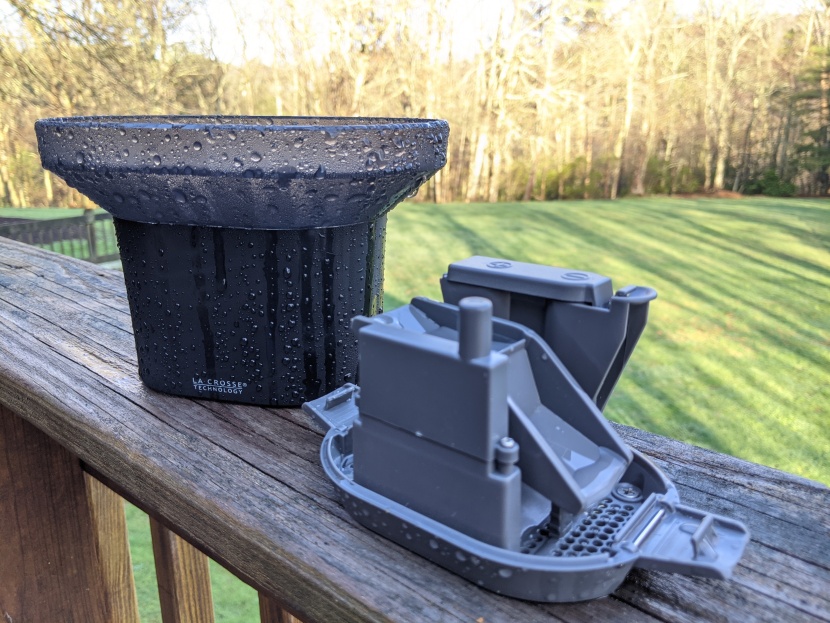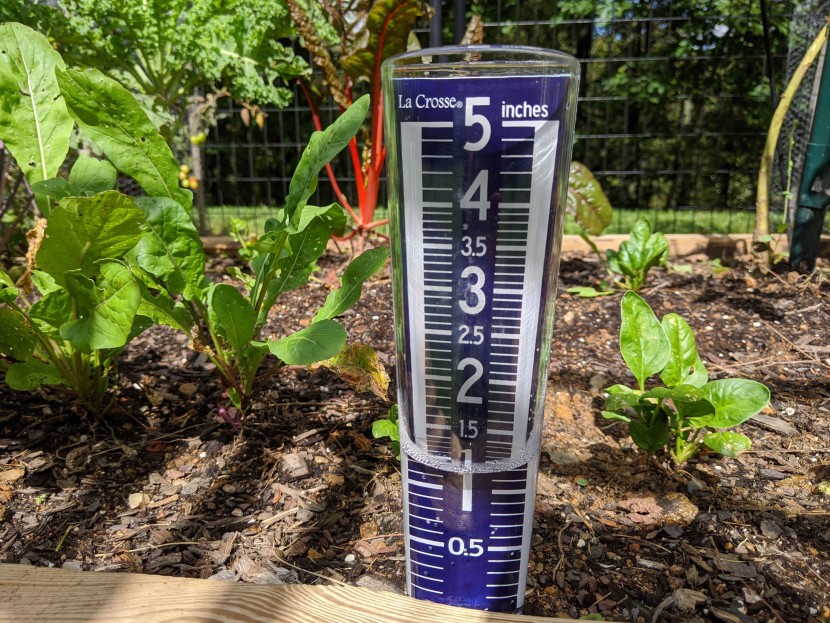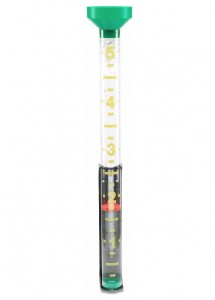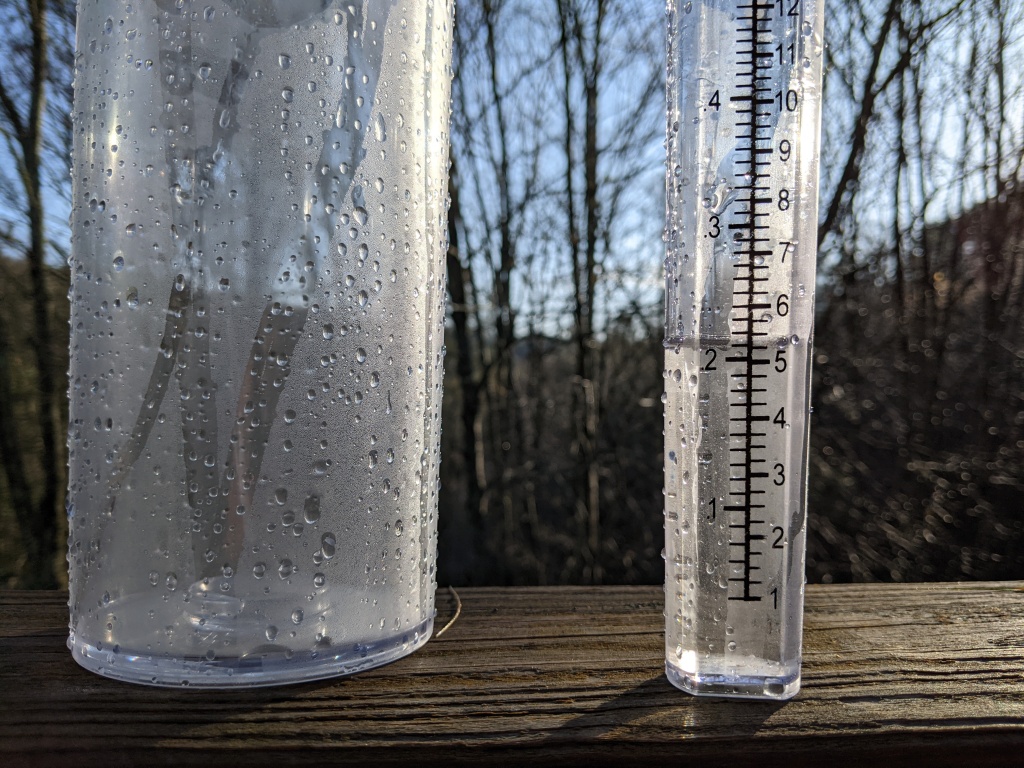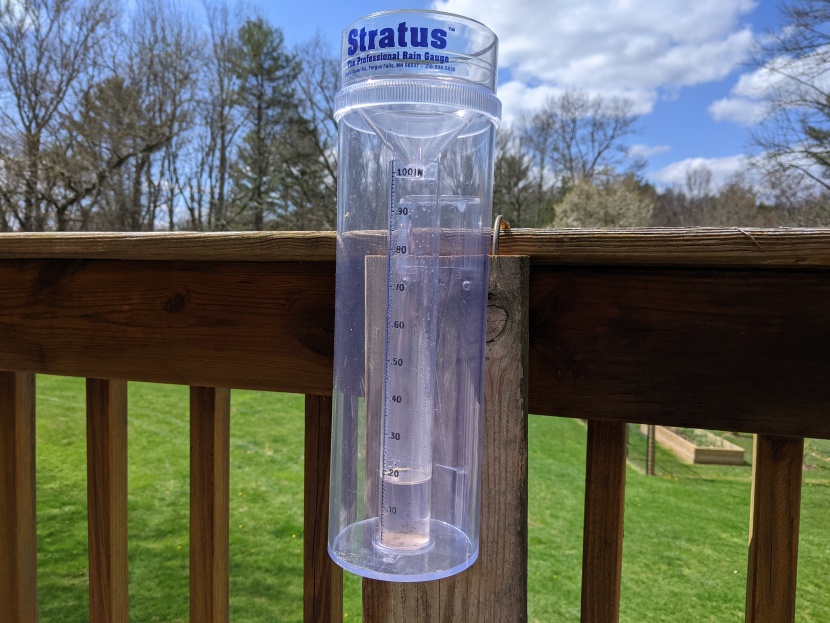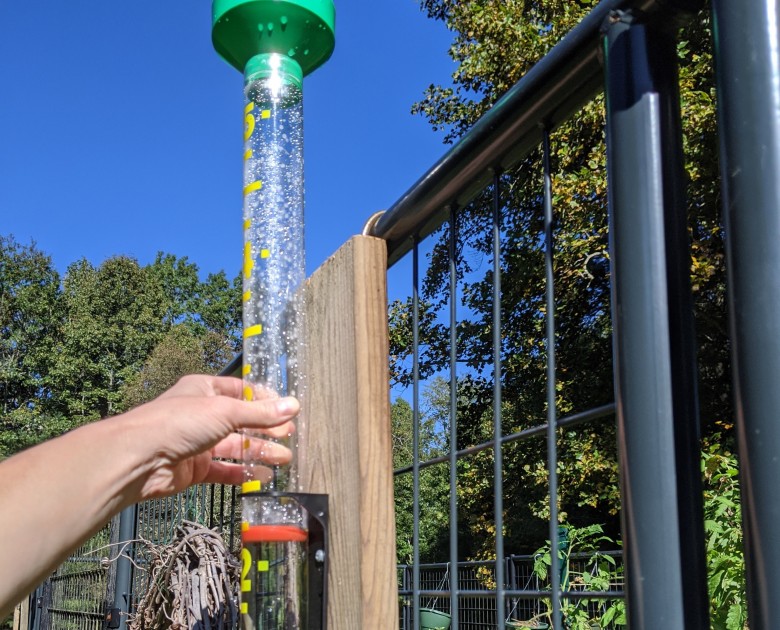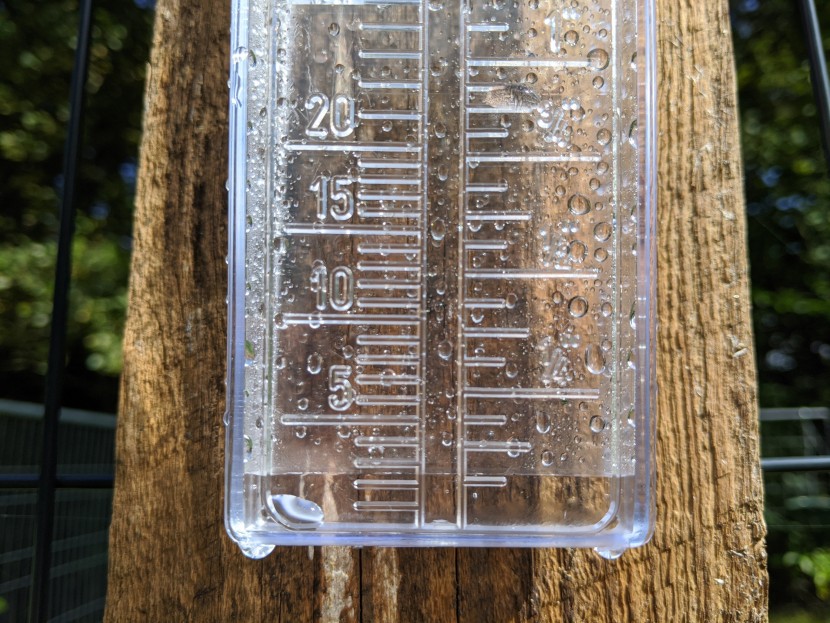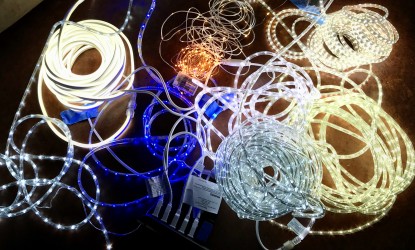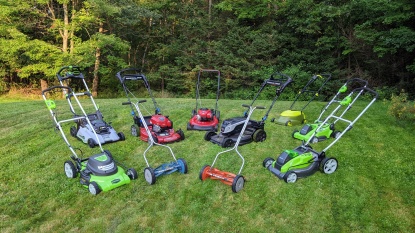
Our Picks of Rain Gauges
Best Digital Rain Gauge
La Crosse Technology 724-1409 Digital
Regarding rain gauges, larger catchment areas make for more accurate readings. The La Crosse Wireless Rain Station has one of the largest in the test. Like all digital rain gauges, it has an outside sensor and an indoor display. The sensor consists of a housing that protects two seesawing cups. They take turns filling with water, tipping over, and spilling it out. The sensor wirelessly sends that information to the indoor display. We like digital gauges because they empty themselves, they capture more data than manual options, and you can check them indoors. The La Crosse version tallies rain totals by the event, hour, day, week, month, and year. It reads rainfall in inches or millimeters and temperature in Celsius or Fahrenheit. This is the highest-scoring digital option, thanks to its accuracy and sturdy housing that keeps insects from meddling with the sensors.
Setting up the display is a straightforward process — just dial in the time, day, month, year, and units of choice. Then decide if you want an alarm to sound when it rains and how much rain needs to fall to trigger it. You can choose in 0.1-inch increments. The outdoor sensor and the indoor display also require pairing, which can be a finicky process. The sensor must be within 300 feet of the display, the largest range of any digital gauge we reviewed. Also, the indoor display is not as user-friendly as we'd like. It quickly deletes your data, rolling over the moment the hour, day, week, month, or year has passed. You'll need discipline and create a separate spreadsheet if you want to keep long-term records. If you want to monitor the rain without standing in it, we recommend the La Crosse for its security and accuracy.
Best Analogue Rain Gauge
Stratus Precision With Mounting Bracket
If you need precise rain measurements further from your house, the Stratus Precision Gauge is your best bet. The opening is just over four inches, a minimum benchmark for the most accurate rain gauge. It's made of sturdy plastic and is large enough to hold 11 inches of rain for even severe storms. Its double-cylinder measuring system provides excellent precision. The inner cylinder measures just one inch of rain to the nearest hundredth. After the first inch, water spills into the larger one. To measure the spillover, dump the first inch and pour the rest into the small cylinder, inch by inch. The lid serves as a funnel to help prevent spills. The mounting plate is straightforward and secure, and the cylinder slides out easily to take a measurement. This gauge is the only option we tested that works in the winter. Remove the funnel and inner tube to capture snow or hail, then melt and measure it.
This gauge requires patience and care if you need precise measurements. But it's fun — for our nerdy testers anyway — to carefully measure each drop. The key is pouring the water slowly, so you don't overfill the funnel and inner cylinder and spill a portion of the rain. If you don't mind working for it, this sturdy, high-volume gauge will reward you with accurate and precise readings.
Best Bang for Your Buck
La Crosse Easy Read 5-Inch
It's hard to think of an easier way to set up a rain gauge. Just plant the La Crosse Easy Read's four-inch plastic spike in the ground and be done with it. While we installed it in the dirt, you can hang the gauge almost as easily on two screws. Placing it higher would make it easier to read without removing it, but you'll have to pick it up to dump it anyway, so we didn't mind. The water magnifies the measurement numbers, making it even easier for our testers to read the measurements. We also like that the Easy Read marks off every tenth of an inch.
The gauge is easy to place in the ground, but you'll want to make sure that you don't place it near vegetation that may shield it from some rainfall, especially in windy conditions. The semi-circle opening measures only 3.1 inches by 1.3 inches, which isn't a lot of room for rain to enter. Therefore, this is not the most accurate rain gauge on the market. Still, it gives you a good idea of rain totals with minimum fuss. And we love that you can move it around your property without remounting a bracket. The best rain gauge is one that you'll use, especially when it comes at an affordable price.
Best Information Breakdown
AcuRite Wireless 00899
The AcuRite Wireless 00899 outdoor sensor and indoor monitor affords you the luxury of checking rain totals without stepping outside. It's also self-draining. Meanwhile, the indoor monitor provides a wealth of information. Like the other digital options, it tracks rain totals for the event, day, and week. The difference is that it stores those totals longer, holding information about the last seven rain events, days, and weeks. It also gives you two tracking modes (called Total A and Total B) that you can control. They begin tracking totals when you turn the gauge on and only stop if you power it off or clear the mode. That means you can track by the month, season, year, or whatever interval is meaningful to you. We appreciate having the extra time to check or record rainfall.
While the gauge does feature a rain alarm, it only has one setting. It sounds for a full minute when the rain starts, which is annoying if you happen to be sleeping. Other rain gauges allow you to set a threshold, like 0.5 inches before the alarm sounds. This model has a similar feature with a separate Flood Watch Alarm, which tracks several predetermined situations that are more likely to saturate soils (for example, 1.4 inches of rainfall in 2 hours). The seven-button monitor has a learning curve, and the monitor and sensor need to be kept within 100 feet of one another. However, it stores more data and gives you more control than the other digital gauges. If you're willing to work a little in dry weather to stay indoors when it's wet, this is a good bet.
Easiest to Read
EZRead Jumbo With Float
The EZRead Jumbo gauge is aptly named. The manufacturer claims that you can read its oversized numbers from up to 50 feet away, and we confirmed it. As such, it is a good option if you want a manual gauge that you can read without stepping outside. Just place it by a window, and you're good to go. The mount requires four screws and a wooden post. When you empty it, which you should do daily in the morning if you're tracking daily totals, simply pinch the plastic holder out of a loop below the mount, pull out the plastic tube, and dump it. The small strainer holes that keep debris out also slow the water down as you pour, but it's still quick. The funnel is over four inches wide, which means it's among the most accurate manual gauges.
On the downside, this rain gauge doesn't deliver very precise measurements to go along with that accuracy. It measures rainfall totals at quarter-inch intervals. Many other contenders measure to the nearest tenth or hundredth of an inch. Another drawback is the plastic is very thin. Our lead tester had one of these rain gauges growing up. The numbers faded, and the funnel cracked under the UV exposure in the Blue Ridge Mountains of Virginia. It happened over five-or-so years, but those who live in a high UV location (or just like their tools to last) might want to consider a more durable option. If you're in a low-lying location with plenty of atmosphere and lots of cloudy days, we think you'll enjoy this straightforward gauge longer.
Compare Products
Why Trust GearLab
We ordered the top gauges at retail stores. Our lead tester mounted the monitors around her garden/mini-farm to keep them away from the influences of trees and buildings. We then took readings every morning during two multi-day tropical storms. After measuring each gauge's opening to understand how well they capture rain in windy weather, we paid close attention to how easy it was to read and record the measurements from each contender. We also noted how simple or challenging each one was to take down and empty. For the three digital and wireless sensors, we scrolled through their measurement options and compared their ease of use. Finally, we scrutinized the construction of each one to see how long they were likely to last.
Clark Tate has been fascinated by the weather since a tornado rounded the bases of her elementary school's tee-ball diamond while she huddled in the basement next door. And, when you're raised in a family of farmers like she was, you're always watching the weather. Clark earned a master's degree in environmental science, which included a meteorology course where she pored over topics like moist adiabatic lapse rates.
Analysis and Test Results
We love tracking rainfall. How cool is it that free, clean water falls from the sky? Monitoring it well can tell you everything from how often you should water your garden to which rivers will likely run. Keep reading to find the right tool to start or continue your weather-watching journey as we dissect the key performance metrics used to evaluate each model with hands-on testing.
What's the Best Value?
After we test how well each rain gauge performs, we look back at how much each one costs to help you find a good value. In this test, there are several. The La Crosse Easy Read 5-Inch gauge is as simple as they come, with a price to match. Easy to read and mount (just stick it in the ground like a stake), it's one of the quickest and least expensive ways to start watching your weather.
The Easy Read doesn't give you much precision, though, and the options that do cost more. For example, the Stratus Precision Gaugeis a manual gauge that costs more than several digital options. It's one of the most accurate gauges in the test, offers very precise readings, works far from any power source, is highly durable, and is the only gauge we tested that works in the winter. So it might be worth the cost if that's what you need. The La Cross digital gauge also offers a great value, earning the highest score in the test at a mid-range price point.
Accuracy
Rainfall varies by micro-location, and one gauge placed within a few meters of another may give you a different reading. Wind can also affect your results by blowing rain sideways against your gauge instead of letting it fall into it. According to Cornell University's Network for Environment and Weather Applications (NEWA) manual, gauges with a four-inch diameter or more are highly accurate. Gauges with an eight-inch diameter are the gold standard used by the National Ocean and Atmospheric Administration, but they are more expensive, awkward, and rare.
Regarding the manual gauges we tested, the Stratus Precision, Outback Blue, and EZRead Jumbo gauges have a four-inch collection diameter. We expect these to be plenty accurate for home garden or landscape upkeep needs.
Two of the digital gauges offer even more impressive catchment areas. The Ecowitt Digital has a collection disk measuring 7.2 inches across. The La Crosse digital's oval-shaped opening measures 4.5 inches by 6.9 inches. Those larger entryways will be less affected by wind and minor variations in rainfall. The openings of the two AcuRite sensors measure only 4 inches by 2.5 inches and can not offer the same level of accuracy. That said, the manual and digital gauges were comparable during our tests, measuring within one-hundredth of an inch of each other.
Record measurements at the same time of day to get the most accurate readings. The morning is best before evaporation ramps up for the day. Then dump the gauge if you need to. The OutdoorHome gauge recommends that you get two gauges to place about 20 feet apart so you can average the readings in case one is affected by factors like wind.
Unlike manual gauges, the accuracy of digital gauges is more complex than just their catchment areas. The mechanical and electrical systems must also be working well and are known to drift over time. The AcuRite versions give detailed instructions for recalibrating them when this occurs. The Ecowitt and La Crosse do not.
NEWA does assure us that even manual gauges that aren't four inches in diameter are fairly accurate and that accuracy is mostly a function of the user. It's important to place your rain gauge well and to read it carefully. For that reason, we expect the OutdoorHome, AcuRite Easy Read, and La Crosse Easy Read to be accurate enough to manage your landscaping or garden as well.
Precision
Of course, even if your gauge is incredibly accurate, if its measurement increments are not very precise, the information you gather will be limited.
The digital gauges prioritize precision and are as easily read as a digital watch. All of them measure rainfall to one one-hundredth of an inch. All measure millimeters of rainfall to the nearest tenth, except for the AcuRite 02446M Wireless, which measures to the nearest hundredth.
As for the manual gauges, the Stratus and Outback Blue options measure rainfall to the nearest hundredth of an inch. The Outback also provides measurements to the nearest quarter of a millimeter. It's an awkward increment, but at least it's metric. It makes sense that these options would be more precise since they are also likely to be more accurate.
The less accurate La Crosse Easy Read also takes a step back in precision, measuring every tenth of an inch. The EZRead Jumbo, which should be quite accurate, reads out every quarter of an inch, bucking the trend. Of course, it's prioritizing big, easy-to-see increments, so that makes sense. While these gauges are less precise, we still enjoy them for a quick and easy look at what the weather is doing.
The OutdoorHome gauge is fairly precise if you use the metric system, as each demarcation is one millimeter. Reading the OutdoorHome and AcuRite Easy Read in inches is awkward since they are broken into unconventional fractions.
Ease of Use
Using digital monitors involves more work up front, but they are easier to use day-to-day, mostly because they empty themselves. The manual monitors require a few screws to install, but you must dump them and record data (if you care to) every time it rains.
If you're looking for a digital option, the AcuRite and La Crosse gauges are easier to set up and use than the Ecowitt. The two AcuRite models use just two screws to secure them to a flat wooden base. The La Crosse takes four.
You need to find a pole that is the proper size to attach the Ecowitt's baseplate and then screw on its somewhat awkward disk. Otherwise, as long as the Ecowitt's sensor is functional (the first one we received was not), adding batteries and pairing both devices is relatively straightforward.
Regarding reading data from the digital options, the AcuRite 02446 is the most intuitive. It cycles easily through the most important information, namely the daily, weekly, and monthly totals. The other options take more time to get used to. Like the manual gauges, if you don't check the accumulations daily, they are lost in the amalgamation of weekly or monthly totals. Except for the AcuRite 00899, which stores the data for seven days.
Though the La Crosse digital gauge has a sturdier, more protected sensor, its monitor is less user-friendly. Each button has multiple uses; it takes time to sort out how to scroll through your rainfall history.
Of the manual gauges, the La Crosse and AcuRite Easy Read gauges are the simplest. Just push them into the ground away from obstructions and pick them back up to read the results. The La Crosse is especially simple since its measurements are in one-tenth inch increments. The AcuRite makes for more complicated math with increments of one-eighth inch.
The EZ Read Jumbo is also incredibly straightforward. All you need is a screwdriver to mount the bracket. Reading the two-inch tall numbers is a breeze. The Stratus Precision and Outback Blue gauges take a few more steps and a bit of precision but are far from difficult to use. The sturdy brackets just require a screwdriver and perhaps a level to install. When you measure totals over an inch, you will need to pour water from the larger cylinders into the smaller ones using the included funnels, but we rather enjoy the ritual.
The OutdoorHome option has a small, easy-to-mount plate, which slides off quickly for a reading. Unfortunately, the colorless numbers and odd increment fractions (one-sixteenth of an inch) make it awkward to read. The metric measurements on the left-hand side are convenient. The La Crosse Waterfall takes two hands to dump, and the red float washes out with the water.
Measuring Capacity
You'll need more capacity if you can't access your gauge reliably after every rainfall event. The digital options excel here since they dump water as they go. Of course, most monitors must be within 100 feet of the sensor, so they don't work well for remote data collection. You can mount the La Crosse sensor up to 300 feet from its monitor.
For truly remote locations, you'll probably want the Stratus or Outback Blue, which both hold 11 inches at a time. After that, capacity drops off considerably. The OutdoorHome measures 6 inches. The EZ Jumbo, La Crosse Waterfall, AcuRite Easy Read, and La Crosse hold 5 inches.
Debris and Durability
A trusted tool that lasts for years is one of life's most satisfying purchases. A good rain gauge should be no different. The digital AcuRite options seem well made and come with calibration instructions so you can keep it running smoothly for years. You do need to be careful with the tabs that attach the housing to the base, though. They seem delicate. Bugs also easily infiltrate the housing and like to take shelter there, which can impact accuracy.
The La Crosse digital gauge has a very sturdy sensor that keeps bugs out. And its connection points seem much sturdier than the two AcuRite options. We aren't as confident in the Ecowitt, mostly because the first unit we tried malfunctioned. It also has a few more parts to it, making it a more complex device.
We think the manual gauges will likely outlast the digital versions. The Stratus and OutdoorHome gauges are made of particularly sturdy plastic. Both rely on raised plastic bars to serve as measurement markers, which are likely to last despite heavy UV exposure.
The Outback Blue, Waterfall, and the two Easy Read options from AcuRite and La Crosse are made of mid-thickness plastic. Still, they all seem ready to last years. The EZRead Jumbo is made of what seems like the thinnest plastic in the test, with painted-on numbers that could fade under the sun. Our lead tester had one for years in childhood. The letters eventually faded, and the funnel cracked.
Conclusion
We hope this review helps you understand how rain gauges work and which model best suits your needs. We wish you beautiful weather, even when it comes in the form of a solid downpour.
Our home & garden experts aim to help you make the most of your space. Whether you want to break ground on a new garden, track some wildlife with a top-rated trail camera, set up a bird feeder or simply kick back in a lawn chair, we have you covered with round-ups and in-depth reviews of the best products on the market.—Clark Tate




